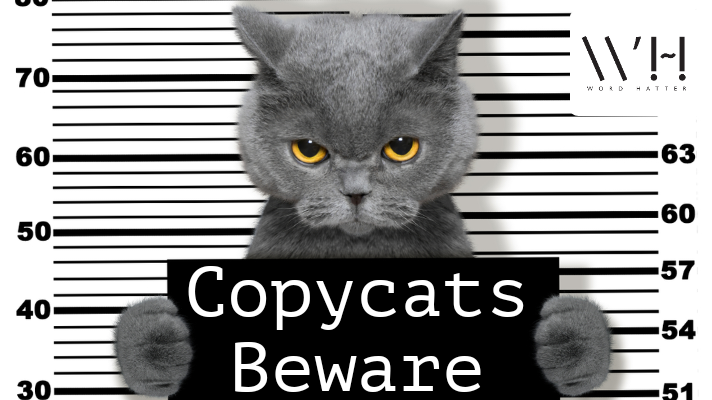Imitation is no longer the best form of flattery and we’re committed to nipping it in the bud.
In a digitally-led world that is free flowing with ideas and thought processes, is it possible to produce something that is truly authentic? Is it possible to be 100% original without knowingly or unknowingly being influenced by someone or something else?
Let’s ponder over this, shall we. Whether you’re an individual or a business, chances are that you have been governed and shaped by certain agents in your environment. These agents could be corporate leaders, authors, professors, scientists, marketers, content creators and so on. They could also be family, friends and social peers. But as important as these normative and technical influences are in moulding your creative process, it is equally important for you to be able to think independently. To be able to create something unique and fresh from your inspiration. Afterall, from a branding point of view, original content is a non-negotiable component in an efficient content marketing campaign!
The question is, what is original content?
Original content refers to material i.e., articles, blogs, eBooks, scripts, illustrations, visual material, that haven’t been posted or published online or offline before. If it has successfully passed a plagiarism check, and no duplicate content like it exists within the digital ecosystem, it is considered original. Not only does original content boost search engine rankings and online visibility, but it also enhances the overall reputation and image of a brand. And, higher credibility equals more business. But with the proliferation of material out there, it is highly rare to find content that meets this very definition. In reality, content evolves over a period of time to incorporate newer perspectives and interpretations. Adidas’s 2017 “Original is Never Finished” campaign said it best. “It’s not about creating something that hasn’t been done before, but about taking something and making it your own”. We think, this is a far more fitting description of what original content is or aspires to be.
Plagiarism Free, Please!
Some of you may be wondering how important this little word, “plagiarism”, is to our narrative. While we’ve talked about a more realistic definition of what original content is, it’s important to understand the difference between being inspired by someone else’s work and disguising someone else’s work as your own work. According to the Merriam-Webster online dictionary, to plagiarise is to:
- Steal and pass off the ideas or words of another as your own
- Use another’s production without crediting the source
- Commit literary theft
- Present as new and original an idea or product derived from an existing source.
Take for example, Kaavya Viswanathan, a Harvard sophomore who plagiarised parts of her published novel, “How Opal Mehta Got Kissed, Got Wild and Got a Life”. The then 19-year old was a huge fan of Megan McCafferty, an author of popular young-adult books, and landed up copy-pasting passages from two of her novels. Once word of this got out, not only did she tarnish her individual reputation, but that of the institution’s. This incident clearly outlines the difference between borrowing inspiration and misappropriating another author’s work.
Introducing PlagScan
How does all of this fit into the context of Word Hatter? Well, as a content agency, we pride ourselves in creating engaging, insightful and strategic content that tell interesting stories. The first step to accomplishing this is ensuring our communication is honest, and our work is authentic and error-free.
We have a paid subscription to PlagScan, a German plagiarism detection software that seeks to safeguard the work of original authors. PlagScan’s expert two-step algorithm compares documents with millions of web sources and internal archives that users can optionally participate in. The powerful software picks up on plagiarism as soon as three consecutive words match a different source. Additionally, the report types cover a wide range of criteria, from a brief indication of the amount of potential plagiarism, to a detailed list of matched sources.
You can be rest assured, once PlagScan has worked its tech wizardry on our work, it is quality approved and ready to be dished out. The fact that it’s German technology provides its own kind of validation, as Germany has managed to leverage homegrown scientific research and expertise to move up the technological ladder.
Subscribe and Thrive
It doesn’t matter if you’re running a business or operating a personal website/blog, you must subscribe to a plagiarism software today. Having a detection program takes all the stress away from creating clean, clear content, as it pin points specific areas that need to be changed or paraphrased. It’s much like having the Sherlock Holmes of words at your disposal!
While there are a number of free plagiarism sites that you can utilise, we’d recommend subscribing to one. Here’s why.
- Free plagiarism checks cross match your submitted text with phrases in online search engine results.
- While it may identify a few matches a few times, this method almost always misses out on the humongous database of material that’s under subscription.
- Paid plagiarism checks, however, enable holistic and structured checking and cross matching against millions of websites and publications submitted worldwide; from blog entries to paid site articles, journals, books and magazines.
- This checking is not merely for a simple text match, but a comprehensive synonym and sentence structure match, compatible across multiple languages and file formats.
- The best part is, these programs avoid showing false positives through an effective filtering process.
So, if you’d like more control over your content, you’d better hit that subscription button soon.
The New-age Consumer
Today’s audience is extremely discerning. They are well read, well-travelled, tech-savvy, and can easily quality compare online. And with the myriad of options available digitally, they will not hesitate to shift to a competitor for access to more reliable and up-to-date sources of information. So, plagiarism-free content is not just an option, but a mandate.
Remember, if your work is tagged as plagiarised, you could be subject to sanctions such as suspension, dismissal from work, penalties and even imprisonment. So, we urge you to take this seriously, not only for your consumer’s sake, but for yours as well.
Have our pointers hit a positive match with your thoughts? If we’ve managed to strike gold, then we’re sure you’ll be making the necessary changes to polish up your content. Write to us if you have any queries or if you’d like to share your thoughts on the same. Until then, stay clean!



